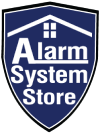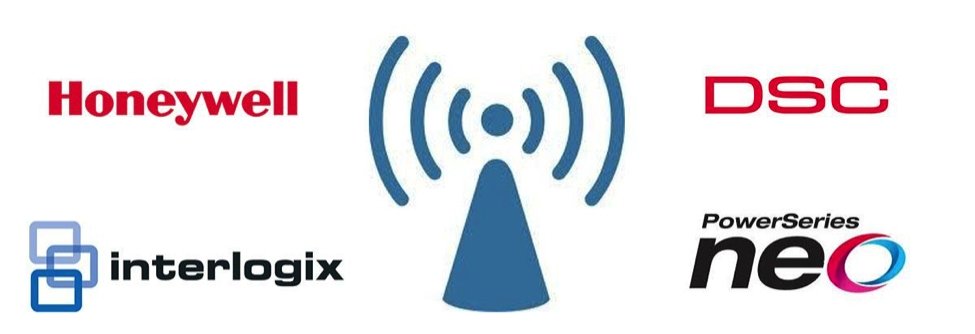
18 Apr 2018
- 0 Comment(s)
A practical comparison and overview of the big 4 wireless security system technology in use today.

Each brand of alarm system manufacturer has their own wireless security technology. For the most part, that technology is used across that brand’s alarm models and not directly compatible with any other brand of alarm system. Each technology has its own pros and cons and its own lineup of sensors and accessories. So we will go over the 4 wireless technologies of the 3 major alarm manufacturer’s that we sell to compare and contrast what they offer. And maybe even determine which is the best technology overall. We will start with Honeywell Security then discuss Interlogix (formerly GE Security) and end with DSC.
Honeywell Wireless: 5800

Honeywell’s wireless technology is called 5800 wireless. The part numbers for all the products that use wireless start with 58 and end with 2 other numbers, often followed by some letters. I can appreciate the consistency of the part numbers since they make it easy to know right away that you are dealing with wireless even if you are not sure what the exact part number is for. The 5800 wireless line uses the 345MHz wavelength.
The wireless range for the Honeywell wireless devices is on the low side of average. There’s no way to give an exact range that you will see in real world applications, but the guidelines that Honeywell gives is about 200 feet. Or in wide open areas such as a large warehouse, they do say that you can have significantly longer range than 200 feet. Honeywell does not give any line of sight range for their wireless devices which we will use to compare to other wireless technologies. But, anecdotally we have seen that Honeywell’s 5800 wireless sensors do not reach as far as DSC sensors and appear to offer similar range to the Interlogix sensors.
One big pro of Honeywell’s wireless line is that there is a great variety of sensors available. They have just about any sensor that you could want. There is an amazing selection of wireless door and window contacts, including multiple recessed versions in addition to the standard surface mount options. Honeywell even has outdoor motion and contact models which is fairly unique. There are motion detectors, shock sensors, environmental sensors, and tilt switches.
Honeywell also has a decent selection of wireless accessories. There is a wireless keypad and wireless key fobs (keychain remotes). And one the more unique wireless devices that Honeywell has is a wireless relay module.
Interlogix Wireless

Interlogix has been thinning out its wireless line, cutting down to primarily their Crystal transmitters. We actually think that this is a good thing. Interlogix is the latest company to own a wide array of independently made alarm systems, previously under GE Security. With all those previous acquisitions the lineup of Interlogix wireless devices offered became more and more bloated. In many cases they would have multiple sensors that looked slightly different, but were functionally the same device with the exact same uses. The current Interlogix wireless sensor catalogue is much more focused without really sacrificing the diversity of uses that are available. They have also improved the overall aesthetics of their wireless devices. While the devices from Interlogix will cover the majority of uses that people need, they do have a little less available when compared to Honeywell.
As for the capability of Interlogix’s wireless technology, they are slightly better than what we saw with Honeywell. Interlogix uses 319.5MHz wavelength for their wireless communication. The effective range is similar. Generally speaking you will see about a 200 foot radius from the receiver. Again this will vary a lot depending on the local installation environment. Under test conditions the line of sight range is up to 1000 feet for most devices. Interlogix wireless devices are also very efficient. So you will only need to change batteries every 5 to 8 years in most cases. This is dependent on the type of device and the amount of use of course, but it is a good guideline to start with.
DSC: 433Mhz

DSC actually has 2 different wireless technologies as of this writing that are not cross compatible with each other. The first is their 433MHz line. This line is compatible with the PowerSeries PC1616, PC1832, and PC1864 (older generation), as well as Impassa, and Alexor systems. It is the older technology of the two from DSC, but is similar in age to what you will see from Honeywell and Interlogix.
It has similar battery life to Honeywell with around 5 years for most devices. A little less overall than what we see with Interlogix, but still pretty good. The device selection is strong as well. They have a full range of devices. They don’t have the outdoor wireless devices that Honeywell and Interlogix have, but they do have some 2-way wireless devices that can provide a lot of value and flexibility. For instance the WT4989 is a 2-way key fob. It functions just like a standard 4 button key fob on the DSC system, but it will also be able to see the status of the system when in range to confirm that the commands have gone through. It has a simple screen that shows different icons to convey that information to you.
While the battery life and device selection are pretty well in line with Honeywell and Interlogix, DSC 433 beats them in wireless range. The line of sight range is 1500 to 2000 feet. This is well over what the previous two can do. In practical use we have seen that 300 feet or more of range is not uncommon. This has given DSC the leg up on the other 2 technologies in many cases, but it is definitely still a very similar technology and not significantly better.
DSC: PowerG

Around 2015 DSC released their update to the PowerSeries: the PowerSeries NEO. There was a variety of upgrades to the PowerSeries, but easily one of the most significant upgrades was the PowerG wireless technology that the NEO could use. Later DSC released the Iotega which also uses PowerG.
PowerG took the older technology and upgraded it in just about every way. Every PowerG device is a 2-way device which allows them to have some features that would not be possible on a device that only broadcasts signals. By default in North America, PowerG uses the 915 MHz wavelength. But DSC added a signal hopping feature that allows PowerG devices to switch to a couple of other frequencies if it is detecting too much interference or even jamming on its default frequency. Another fairly unique feature of PowerG compared to the previous technologies is that its signals are 128 bit AES encrypted which adds an extra layer of security. The expected battery life of PowerG is as good or potentially better than that of Interlogix. This is thanks to the adaptive power transmission feature that the devices have. What the devices will do is calibrate with the host transceiver to determine how strong a signal they need to send to reliably communicate. So if the device is only 10 feet away it does not need to send a signal at full power to reliably communicate so it won’t to help save battery life.
This brings us to the most impressive upgrade that the PowerG devices have: range. The line of sight range for PowerG devices is up to 1.24 miles. This about 6500 feet or more than 3 times farther than the previous champion. We have yet to see what the upper limits are in practical use because we haven’t really heard of a case where the range was an issue. The only times we’ve seen it fail is in cases where people are trying to send signals through solid metal sided and roofed buildings. But using the other technologies as a guide, we’d guess you’ll see about 1000 feet or more.
The only downside to PowerG that we see is the relatively limited device selection. For instance, there is no recessed PowerG contact at this time. However, the devices that are available cover the vast majority of uses and the most popular device types.
If you’ve made it this far, you should see who we think is the pretty clear winner out of these four wireless technologies. PowerG offers a more modern take on technology that has been around for a couple of decades now. And in doing so it is able to beat the other three options by having superior features.

